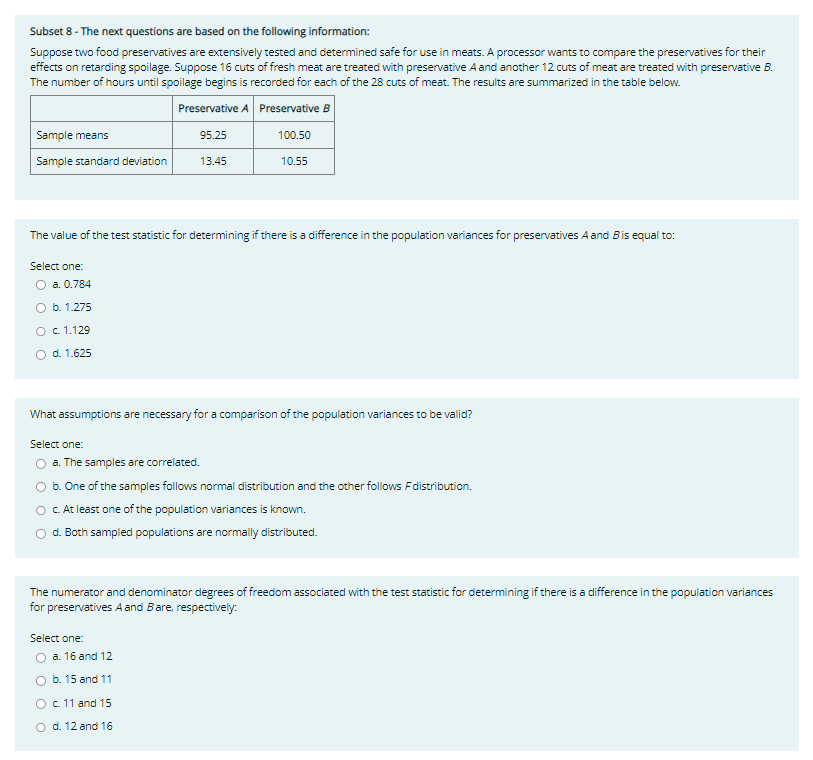Suppose two food preservatives are extensively tested and determined safe for use in meats. A processor wants to compare the preservatives for their effects on retarding spoilage. Suppose 16 cuts of fresh meat are treated with preservative A and another 12 cuts of meat are treated with preservative B. The number of hours until spoilage begins is recorded for each of the 28 cuts of meat. The results are summarized in the table below. Preservative A Preservative B 100.50 10.55 Sample means Sample standard deviation 95.25 13.45 The value of the test statistic for determining if there is a difference in the population variances for preservatives A and B is equal to: Select one: O a. 0.784 O b. 1.275 c. 1.129 d. 1.625 What assumptions are necessary for a comparison of the population variances to be valid? Select one: O a. The samples are correlated. b. One of the samples follows normal distribution and the other follows F distribution. O c. At least one of the population variances is known. O d. Both sampled populations are normally distributed. Select one: O a. 16 and 12 b. 15 and 11 O c. 11 and 15 O d. 12 and 16 The numerator and denominator degrees of freedom associated with the test statistic for determining if there is a difference in the population variances for preservatives A and B are, respectively:
Suppose two food preservatives are extensively tested and determined safe for use in meats. A processor wants to compare the preservatives for their effects on retarding spoilage. Suppose 16 cuts of fresh meat are treated with preservative A and another 12 cuts of meat are treated with preservative B. The number of hours until spoilage begins is recorded for each of the 28 cuts of meat. The results are summarized in the table below. Preservative A Preservative B 100.50 10.55 Sample means Sample standard deviation 95.25 13.45 The value of the test statistic for determining if there is a difference in the population variances for preservatives A and B is equal to: Select one: O a. 0.784 O b. 1.275 c. 1.129 d. 1.625 What assumptions are necessary for a comparison of the population variances to be valid? Select one: O a. The samples are correlated. b. One of the samples follows normal distribution and the other follows F distribution. O c. At least one of the population variances is known. O d. Both sampled populations are normally distributed. Select one: O a. 16 and 12 b. 15 and 11 O c. 11 and 15 O d. 12 and 16 The numerator and denominator degrees of freedom associated with the test statistic for determining if there is a difference in the population variances for preservatives A and B are, respectively:
Chapter9: Sequences, Probability And Counting Theory
Section: Chapter Questions
Problem 21PT: How many distinct ways can the word EVANESCENCE be arranged if the anagram must end with the letter...
Related questions
Question

Transcribed Image Text:Subset 8- The next questions are based on the following information:
Suppose two food preservatives are extensively tested and determined safe for use in meats. A processor wants to compare the preservatives for their
effects on retarding spoilage. Suppose 16 cuts of fresh meat are treated with preservative A and another 12 cuts of meat are treated with preservative B.
The number of hours until spoilage begins is recorded for each of the 28 cuts of meat. The results are summarized in the table below.
Preservative A
Preservative B
95.25
100.50
13.45
Sample means
Sample standard deviation
The value of the test statistic for determining if there is a difference in the population variances for preservatives A and B is equal to:
Select one:
O a. 0.784
O b. 1.275
O c. 1.129
d. 1.625
What assumptions are necessary for a comparison of the population variances to be valid?
Select one:
a. The samples are correlated.
10.55
b. One of the samples follows normal distribution and the other follows F distribution.
c. At least one of the population variances is known.
d. Both sampled populations are normally distributed.
The numerator and denominator degrees of freedom associated with the test statistic for determining if there is a difference in the population variances
for preservatives A and B are, respectively:
Select one:
a. 16 and 12
b. 15 and 11
O c. 11 and 15
O d. 12 and 16
Expert Solution
This question has been solved!
Explore an expertly crafted, step-by-step solution for a thorough understanding of key concepts.
Step by step
Solved in 2 steps with 1 images

Recommended textbooks for you


College Algebra (MindTap Course List)
Algebra
ISBN:
9781305652231
Author:
R. David Gustafson, Jeff Hughes
Publisher:
Cengage Learning


College Algebra (MindTap Course List)
Algebra
ISBN:
9781305652231
Author:
R. David Gustafson, Jeff Hughes
Publisher:
Cengage Learning